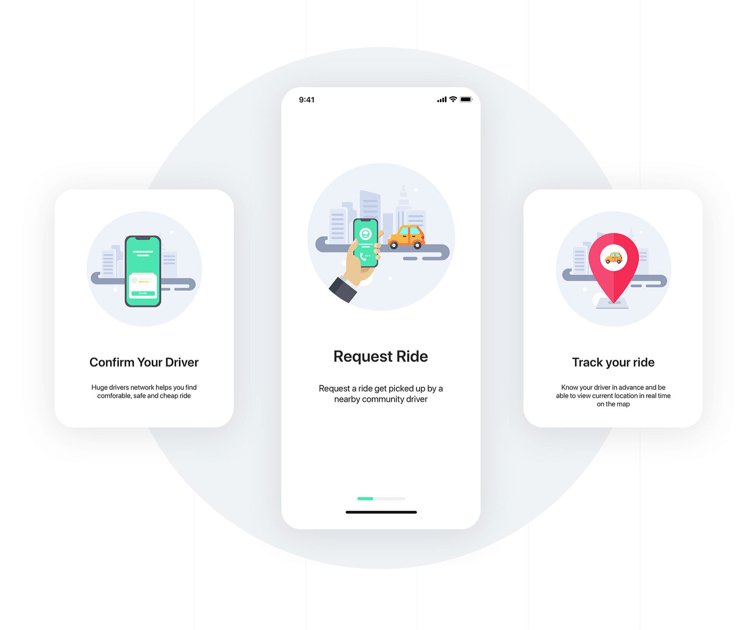Whenever a need for taxi booking arises, Uber on our smartphones is what first comes to our mind. It’s a big reality of the taxi industry unless you are living under the rock.
Uber- the taxi-hailing service provider has made inroads into the USA taxi market when the mobile apps usage was picking up the pace. The one-of-a-kind business model has connected passengers who need taxi swiftly and the drivers looking for the passengers for a ride.

With continuous improvements, Uber has evolved into a complete App solution that has made taxi booking passenger-oriented with driver’s tracking on a map, advanced fare calculation, multiple payment options, rating system, and in-app chatting. Not just the problems of the passengers are solved, but the myriad of the monetizing opportunities are also created for independent drivers who own vehicles.
The individuality of the business model enabled Uber to reinvent the taxi industry with an extensive network of drivers across 84 countries worldwide, which worth nearly $72 billion, and generating $11.3 billion as revenue. The fun fact is the largest competitors of Uber earn just a fraction of Uber’s annual revenue.
Read more : How to make a Taxi/Cab Booking App like Uber?
It doesn’t mean there is no room left for the new taxi businesses to outgrow, outperform, and outdo Uber in the global market. Instead of having a large market share, a huge impact on the on-demand economy, and the high number of drivers on the road, the new entrants have built an Uber clone app and defeated Uber with the right strategy in place.
Ola, Lyft, GrabTaxi, Didi Dache, and Kuaidi Dache are some of the start-ups that have scored immense success in the ride-hailing industry with smart marketing tactics. Do you want to build a successful taxi business like- Uber? If so, here are the secret ingredients to become better of the Uber:
The high-end taxi services will get major traction
The traditional taxi cab medallions in different countries have faced a sharp drop in the net value after Uber enters the taxi markets and started providing inexpensive app-based services. Black cabs in London, green taxis in the States, Private Chauffeur in Paris, and other cab companies are the best instances of it that are threatened with Uber entry and alleged Uber for the violation of antitrust law, which was later dismissed by the court. It signals the medallion owners need to find ways to again hold a grip on the market.
The lesson learned from the medallion owners that are losing the competition to Uber is there exist opportunities for new taxi businesses to connect the passengers with licensed taxi drivers through the mobile app. The Arro, Flywheel, and Way2Ride in the USA have brilliantly made the most out of the opportunity.
The alternative vehicles are making an important space
When we try to understand the real mechanics of Uber business, the innovation remains a cardinal aspect of its tremendous growth and high profitability. In the same vein, the company launched a motorbike service where on-demand rides on two-wheeled vehicles using an ios and Android mobile app are offered to the people.
However, the company suspended the motorbike service that was started in Bangkok and later, it tries to make inroads into the Southeast Asia market that are highly suffering from the congestion issues, but Uber is having a hard time with its closest rival- Grab. The regulatory pushback and competition have made Uber handicapped in the micro-mobility movement (Alternative vehicle).

When we look at the percentage of motorbikes and cars that households of different countries have- the car is the clear winner with some exceptions such as Indonesia, China, Thailand, and Malaysia where app-based motorbike booking is on the rise. The new players can gain momentum in these regions by adding motorbike services as a natural extension to the car booking services.
- Engineer the surge-free (Pricing) taxi app
We all have experienced paying high fare when booking the Uber taxi due to the surge in pricing during peak hours. The company has taken the initiative to match the driver’s supply and passenger demand for the taxi.
This tactic has helped in minimizing the waiting time and keeping the vehicles moving. However, it resulted in a massive churn and the passengers have started looking to the alternatives.
That’s where a few taxi apps such as Curb and Gett have made the mark by making the taxi-hailing cabs surge-free and gained a competitive advantage over Uber.
- Ensure quality service
Despite deploying women drivers, checking the driver’s behavior, the track record, and the background is all-important to ensure safe and secure rides. This is the point where Uber missed the mark and not checked the driver’s profile. According to statistics, Uber drivers are investigated and convicted for the sexual offenses and violent crimes that have resulted in their license denial by London Police.

The new start-ups can build the business credibility and trustworthiness by checking the criminal record and background of the drivers, and ensuring that they follow the driving rules and regulations provided by the local government.
Tap into the unexplored territories
Uber has indeed extended its reach to worldwide passengers, but the complete universe is not covered yet. Still, there are some of the countries where Uber is not present like- in Muscat and Nizwa, Oman, Abu Dhabi, UAE, Beirut and Byblos, Lebanon, Petra and Amman, Jordan, and Kuwait. Additionally, there are some regions where Uber services are banned due to sexual offenses or violent crimes done by drivers. The license suspension has created room for the budding entrepreneurs to fill the void.
The untouched regions become the ideal locations for many taxi businesses to offer the app-based taxi booking services locally and then, they started gaining ground regionally.
The marketing tactics have helped many taxi start-ups to pave the way to success with a wider networking area and growing ROI. Let’s take a sneak peek inside at how start-ups had written the success stories:
- Ola
Ola was launched in 2010 to resolve the huge issues of hiring cars for cross-city travels in Indian society. Well, the idea of building the Ola Cabs emerged from the situation when the young entrepreneurs- Bhavish Aggarwal and Ankit Bhati were abandoned by the cab driver in the middle of the road. It’s the fastest-growing start-up in India, that’s winning against the global competitor Uber with 60% market share, and one million driver-partners network across 110 cities of India.
- Arro
Initially, the start-up launched in 2015 in New York, and later expanded to Chicago, Houston, San Francisco, and Boston. Aiming to support the classic taxi services, Arro allows passengers to e-hail the cab and make the payment for green or yellow cabs.
The start-up partnered with Creative Mobile Technologies (CMT), the company that installs the taximeters, video screens, and payment systems in yellow and green cabs. Using Arro, the taxi drivers don’t require any mobile interface to get the booking request; instead, the booking requests are sent directly to CMT terminals.
- Lyft
While standing neck to neck with Uber, Lyft has managed to continuously grow and stay profitable with $3.5 billion as revenue. Since 2007, Lyft has surprised everyone with its unique marketing strategies and plans while securing the second position in ride-sharing facilities.
Putting fuzzy mustaches on the car’s front, pioneering the women drivers’ concept, encouraging the riders to sit at the car’s front seat, and the concept of community building has brought insane popularity to Lyft. The announcements for expanding the Lyft services to 100 more cities of the USA in 2017 are the result of their unique business attitude.
Read more : White-label Taxi Application Vs. Custom-Built App
- Tootle
Realizing the traffic problem of Kathmandu in Nepal that tourists and locals were facing, a group of college students has created a ride-hailing app that serves the passenger’s travel needs with motorbike drivers. With two different interfaces- one for motorbike drivers and another for the passenger, the passengers and drivers can get connected.
The business model is the same as Uber where the payments can be accepted by the drivers in cash or as a Tootle wallet. However, the drivers can pocket just around 64% of the fare and the rest is consumed as government taxes and Tootle commission.
- Flywheel
The ride-hailing platform was founded in 2009 and works in a purely traditional way. Later, it has mobilized the services with the Taxi iOS app development.
Some of its unique offerings such as GPS-based rates, new dispatching technology that’s supporting yellow and green taxi drivers and no-surge in fare have helped Flywheel to gain a competitive advantage over Uber. The regulated taxis and high-level screening of the drivers are the plus points that helped the company to expand its network to 1800 active drivers across different cities of the USA.
- GrabTaxi
The taxi-hailing app has steered its journey from Malaysia’s garage to Southeast Asia’s most valuable tech unicorn when the founder- Tan Anthony has tried to address all the issues associated with the taxi system in Malaysia through GrabTaxi app.
The secured rides with high-screening of drivers, lower cut per booking from the driver, and the unique problem-solving approach have brought GrabTaxi to the position where it’s standing now. Although the journey was not plain-sailing, the company learned from the mistakes and made it up.
This is the reason the company has managed to expand its network to 168 cities of the 8 countries and reached a revenue of 2.3 billion in 2019. The company has also made the mark in ride-hailing services through motorbikes and continuously scaling.

Wrapping it up
Every coin has two faces- success or failure. There is no surefire way to gain success and failure brings a lesson for the mistakes to not repeat. Uber won the market because of its unique app idea and intelligently execution of the strategy.
Still, some aspects are not covered under Uber’s marketing plan and a few things are done incorrectly, which has created an opportunity for the new taxi businesses to survive and thrive in the taxi industry and hold a big share.
What’s more? Everything is covered in the blog which tells you how those start-ups have cherished epic success. Have you found any such unmet need for the taxi industry? Want to fill the void with taxi app development? It’s a great decision! Go ahead and partner with a taxi app development service provider to make your start-up fall into the list of success stories.









